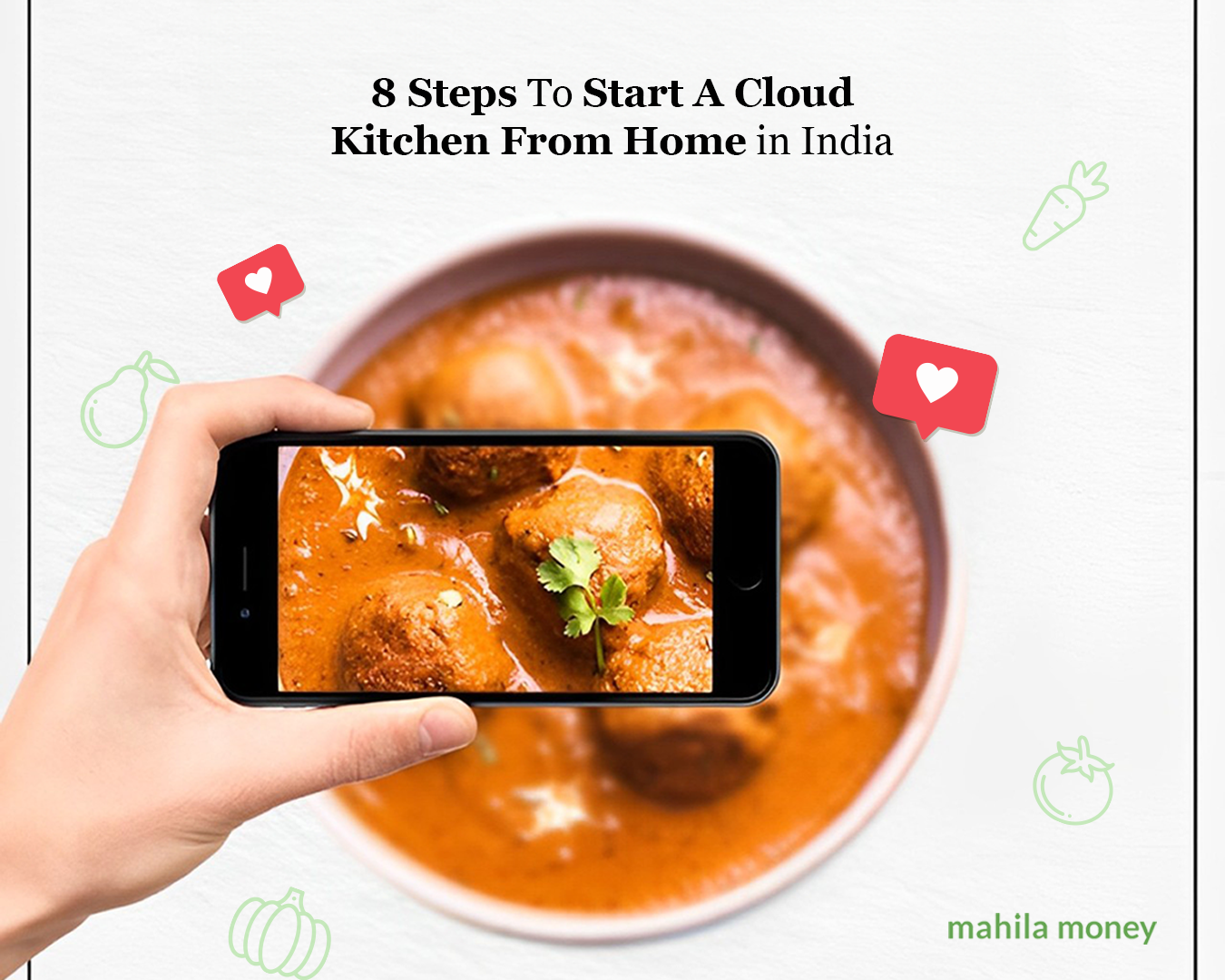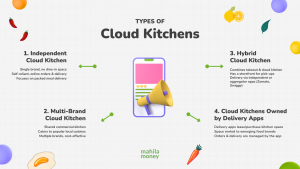Discover steps to start a cloud kitchen from home in India in 8 simple steps and turn your dreams into reality.
Can I run a cloud kitchen from home in India? How to start a cloud kitchen? If you are eager to start a cloud kitchen from home, you are at the right place. In the rapidly changing food industry, cloud kitchens have become a cost-effective solution to high rental costs. For aspiring entrepreneurs questioning, “Can I start a cloud kitchen from home? This article provides a comprehensive guide on how to start a cloud kitchen business in India. Discover the step-by-step process of establishing a successful cloud kitchen from the comfort of your home and unlock the potential of this innovative business model.
Apply for a business loan
What is a Cloud Kitchen & How Does It Function?
Before we dive deeper, did you know that according to Markets and Data, the Indian cloud kitchen market was estimated at USD 1.09 billion in FY2023 and is projected to reach USD 3.2 billion by the end of FY2031, growing at a CAGR of 16.63% during FY2024-FY2031? This growth highlights the immense potential of cloud kitchens in India.
A cloud kitchen, also known as a dark kitchen, ghost kitchen, virtual restaurant, or satellite kitchen, is primarily a restaurant kitchen that accepts orders online and offers no dine-in facility. Unlike traditional restaurants, cloud kitchens are designed to cater solely to the demand generated by the end users.
Also, if you’re still wondering, “Can I start a cloud kitchen from home?” Here are two case studies for you. Risika Jain from Hyderabad and Manasi Apte from Nagpur have successfully built independent cloud kitchen businesses through Mahila Money Loan. They are achieving great success in their ventures. Don’t miss their success story; it might inspire you as well.
Cloud kitchens can operate via their online ordering app or website or partner with various food delivery platforms such as Swiggy and Zomato. Since the primary revenue for these internet restaurants comes from multiple food ordering platforms, having a Point of Sale (POS) software is crucial. This software streamlines the process by accepting orders from various sources, eliminating the hassle of manually tracking and calculating orders at the end of each day.
8 Steps To Start A Cloud Kitchen From Home in India
Step 1: Research and Planning
Identify Your Niche: Decide on the cuisine or food items you want to offer. Consider your culinary strengths, local demand, and competition.
Market Analysis: Study your target audience’s preferences, buying habits, and pain points to understand them. Analyze competitors to find market gaps where your business can stand out.
Customer Acquisition Strategy: Plan how you’ll attract customers. Popular methods include:
- Launching on food delivery platforms like Zomato and Swiggy.
- Offering first-time discounts.
- Leveraging word-of-mouth marketing.
Branding Strategy: Define your brand identity. Choose a name, logo, and aesthetic that reflects your cuisine style—healthy eating, gourmet, or comfort food. Ensure consistency across all platforms.
Social Media Presence: Decide on the tone of your communication—fun and engaging or professional and informative. Develop a social media content calendar to engage with your audience consistently.
Marketing Campaigns: Plan promotional strategies such as social media ads, influencer partnerships, email campaigns, and special offers—set metrics to measure the success of each campaign and optimize it for better results.
Mahila Money Pro Tip:
Start with a soft launch or a limited menu to test your concept. Use this phase to gather customer feedback and refine your offerings before scaling up.
Step 2: Develop a Business Plan
Budgeting: Estimate startup costs, including kitchen equipment (stoves, refrigerators, utensils), packaging materials, and marketing expenses. Don’t forget to budget for professional photography to showcase your dishes online. Include funds for necessary licenses (FSSAI, GST) and operational costs (raw materials, utilities, and delivery fees).
Menu Planning: Design a concise and practical menu that highlights your strengths. Use local suppliers for fresh ingredients, price your dishes competitively while considering your target market’s spending habits, and standardize recipes to ensure quality and consistency.
Mahila Money Pro Tip:
Start with a well-curated menu and gradually expand based on customer feedback. This helps manage inventory efficiently and reduces the risk of wastage.
Step 3: Implement Online Food Ordering
Partner with Food Delivery Platforms: Register your cloud kitchen on popular platforms like Swiggy, Zomato, or Foodpanda. These platforms typically charge 18-30% of revenue per order.
Use a POS System: Implement a Point of Sale (POS) system like Posist, SlickPOS, or PetPooja to streamline order management and offer customers real-time order tracking. The POS should generate comprehensive sales reports and provide real-time inventory and cash flow data.
Mahila Money Pro Tip:
A sound POS system helps monitor sales, cash, and inventory effectively. Look for systems that offer clarity through charts and easy-to-use dashboards.
Step 4: Obtain Essential Licenses
Licensing and Compliance: To ensure compliance, obtain licenses such as FSSAI, GST registration, health trade permits, and fire safety certificates. Consider hiring a professional agency to assist in obtaining these licenses.
Mahila Money Pro Tip:
Acquire essential licenses early to avoid legal complications. Depending on local regulations, other permits may include a Pollution certificate, Environmental Clearance, and Night Operations License.
Step 5: Set Up Kitchen Equipment, Raw Materials, and Packaging
Kitchen Setup: Your equipment will vary depending on your cuisine, but expect to spend around ₹2,00,000 on essentials like refrigerators, burners, and storage. Efficiently source equipment and raw materials from reliable vendors.
Packaging: High-quality packaging is essential to maintaining food freshness and reinforcing your brand identity. Packaging should be leak-proof, easy to transport, and, if possible, environmentally friendly.
Mahila Money Pro Tip:
Build strong relationships with local suppliers to secure better rates and ensure a consistent supply of ingredients.
Step 6: Hire the Right Staff
Staffing Needs: Hire skilled personnel like chefs, assistants, and support staff. Typically, cloud kitchens require at least two chefs, two assistants, and a housekeeper—partner with third-party delivery services for logistics.
Mahila Money Pro Tip:
Ensure staff maintains hygiene standards with uniforms, including masks, gloves, and hair caps. This fosters professionalism and builds customer trust.
Step 7: Equip with Communication Tools and Miscellaneous Items
Communication Tools: Invest in landlines, mobile phones, and high-speed internet to ensure seamless communication. Cloud telephony systems with recording features help improve customer service and staff training.
Mahila Money Pro Tip:
Use CRM software to track customer interactions and personalize your services. CRM integration with telephony systems allows better customer relationship management and marketing efforts.
Step 8: Market Your Cloud Kitchen
Strategic Marketing: Register your business on food listing platforms like Zomato and TripAdvisor. Leverage social media to run exclusive deals and encourage customer reviews. Invest in online advertising to boost visibility and customer acquisition.
Mahila Money Pro Tip:
Utilize data analytics to monitor customer behaviour and preferences. Tailor your marketing efforts based on insights to offer personalized deals, improving customer retention and standing out in the competitive market.
Future of Cloud Kitchen in India
The cloud kitchen industry in India is on a promising trajectory, projected to reach an impressive $1.9 billion by FY26. The integration of technology and automation in restaurant operations is beneficial. Cloud kitchens are capitalizing on standardized food quality and flavour, alongside time-saving kitchen automation tools powered by AI and machine learning, to maintain a competitive edge. The industry’s expansion is further marked by Quick Service Restaurants (QSRs) entering the cloud kitchen domain, the rise of alternative ordering and delivery platforms, and increasing demand from Tier 2, 3, and 4 cities. This ongoing growth highlights the dynamic evolution of cloud kitchens in India’s culinary landscape. Follow these 8 steps to start a cloud kitchen from home in India and turn your dreams into reality.
Read more:
5 Smart Tips To Get A Small Business Loan During the Festive Season
5 Small Business Packaging Ideas for the Festive Season
How To Boost Sales on Social Media During the Festive Season

If you are a woman entrepreneur who wants to take your business to new heights and is in need of working capital and entrepreneurship resources, come speak to us on Mahila Money. For more such #JiyoApneDumPe live conversations, download the Mahila Money App on Play Store or visit us on www.mahila.money






Bravo, is simply magnificent idea
Great post but I was wanting to know if you could write a litte more on this subject?
I’d be very thankful if you could elaborate a little bit further.
Cheers!
Want to start cloud kitchen from home
Want to start a kitchen from home
I want to start cloud kitchen
Hi Priya, glad that you are thinking of starting a venture. All the best. If you need any support/guidance, feel free to join Mahila Money Open House every Mon-Fri, 12:00-12:45 PM. Download the Mahila Money app to join.